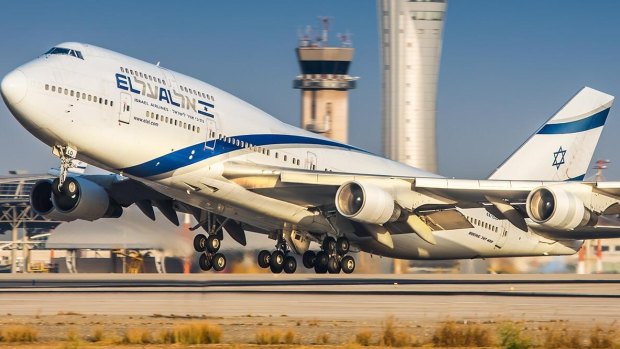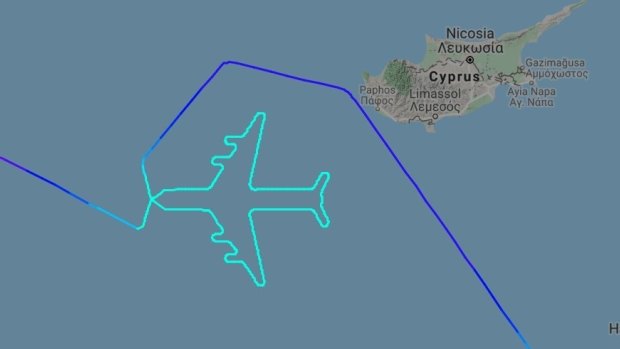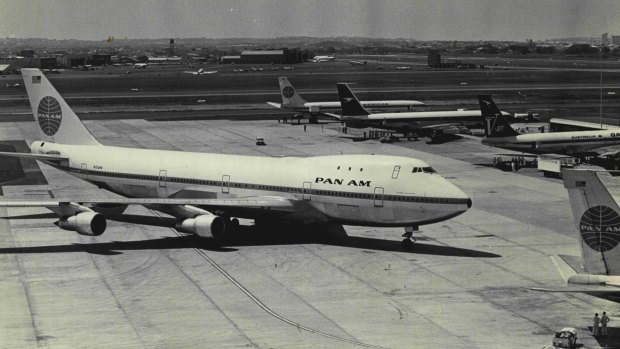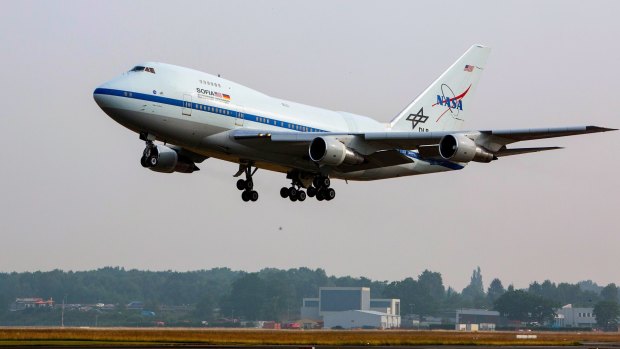This was published 4 years ago
El Al Boeing 747 jumbo jet final flight makes 'sky painting' with radar pattern
By Oliver Smith

El Al Airlines retired its final Boeing 747 with a giant Etch A Sketch-in-the-sky tribute on Sunday.Credit: El Al
El Al, Israel's flag carrier, has retired the last of its 747s, with the captain of the final service from Rome to Tel Aviv putting the journey on hold to trace the outline of a jumbo jet in the sky.
The stunt, captured on the plane tracking website FlightRadar24, certainly wasn't spontaneous. Dozens of additional waypoints were added to the flight plan to make sure the drawing would be precise, while air traffic control in nearby Cyprus were informed in advance.

Credit: Flightradar24.com
Passengers were in onboard, too. Tickets for the service were only available to El Al's Matmid Frequent Flyer Club members, and the airborne farewell party featured staff in retro uniforms dishing out free cocktails. Sam Chui, a blogger on board, said passengers were even permitted to visit the cockpit at 35,000 feet.

Credit: Flightradar24.com
The retirement marked the end of a 48-year relationship between El Al and the 747, the Queen of the Skies, a partnership which began on July 2, 1971, when Flight Y001 established the first non-stop link between Israel and New York.
It also marks another chapter in the slow death of the jumbo jet, arguably the most iconic aircraft model of all time.
Since 1970, when it made its debut with Pan Am, Boeing has produced 1,553 jumbos, according to the website Airfleets.net. Less than a third of those are still in service, while three of its five biggest customers are cargo airlines.
British Airways has more 747s than any other passenger airline: 33. But since 2017 it has retired three and plans to get rid of the rest by 2024.
In December 2017, United waved goodbye to its final 747 with a farewell flight from San Francisco to Honolulu (recreating the route of its first 747 service in 1970). Last year Delta followed suit, sending its last 747 to an Arizona "boneyard". Not one US carrier now flies the jumbo.
In the last two years Korean Air has retired four 747s, leaving 23 in its fleet – 11 of which are used solely for cargo services. KLM has also ditched four, taking its total from 17 to 13, while Qantas has shifted three, leaving it with just six. Qantas will retire all its 747s by 2021.
After BA, Lufthansa is the biggest 747 user. But it plans to replace almost half of its 32 jumbo jets with Boeing 777s by 2025. Of the other airlines on the list above, it should be noted that Singapore Airlines and Cathay Pacific only use the 747 for cargo flights.
Demand for the jumbo jet, which has been tweaked and upgraded many times over the years, has dried up. No new orders were received this year and in the last few years all new 747s have gone to cargo companies like UPS. As far as passenger services are concerned, the end is nigh.
Why don't passenger airlines want it?
Airlines are opting to buy medium-sized twin-engine planes instead, such as the 787 Dreamliner, the Airbus A320neo, which launched in 2016, and the A350, introduced in 2015. All these models are far easier to fill and cheaper to maintain than the 747. These are the same factors that explain the demise of the A380, the biggest passenger plane of all time.
Such is the popularity of the A320 that Airbus claims one takes off or lands somewhere in the world every two seconds. Its latest version, the A320neo, has received more than 6600 orders from around 70 airlines, making it the fastest-selling commercial aircraft in history.
See also: Death of the A380: Airline to ditch entire superjumbo fleet
Where's the first 747?
The first 747 flight took place in February 1969, with test pilots Jack Waddell and Brien Wygle at the controls, and ushered in a new era of air travel when it took off – it was twice the size of its nearest competitor. The aircraft, RA001, can be seen at Seattle's Museum of Flight.
The first passenger flight

Credit: Antony Matheus Linsen
Pan Am introduced the paying public to the jumbo jet on January 22, 1970. But that first flight, from New York to Heathrow, wasn't a roaring success.
"The widebody's 352 passengers and 20 crew members sat on the runway for two hours, waiting to take off from Kennedy Airport, before Captain Robert Weeks noticed a malfunction in the #4 engine and decided to head back to the gate," explains Tony Reichhardt, writing for Air Space Magazine. "The passengers disembarked (a group of protesters, who had loudly complained about the 747′s noise and pollution, taunted them with "We told you so!") and were treated to dinner in the terminal while Pan Am rustled up a replacement jet. Twenty of the original passengers bailed out right there, choosing to miss out on the historic first flight.
"The stand-in 747, hastily christened 'Young America' (the name of the original airplane) finally took off at 1:52am, 27 minutes after it was supposed to have landed in London."
The oldest 747 still in service
Caspian Airlines Cargo possesses an active 50-year-old 747. It began life with TWA before being converted by Boeing in 1975 and delivered to the Iran Air Force a year later. Iran Air briefly used it for passenger services in the Eighties, before it was returned to military hands. Caspian Airlines bought it in 2018.
The oldest 747 still flying ordinary punters is owned by Iran's Mahan Air. It first flew in 1986 and has been on Mahan's books since 2007.
The majority of BA's active jumbos are far newer. The oldest, G-BNLY, was delivered in 1993; the newest, G-BYGG, in 1999.
Where do unwanted 747s go?
With airlines keen to keep their fleets as modern and fuel efficient as possible, and air forces eager to take advantage of new technology, the shelf life of a plane is shorter than you'd think. Where do they go when they are retired? The chances are they will end up at one of the world's vast aircraft graveyards.
There are dozens of facilities around the world where retired planes are kept in storage or to have their parts removed and reused or sold. The first such graveyards, or "boneyards" in US parlance, were established after the Second World War, when militaries found themselves with huge aircraft surpluses.
The largest is the 309th Aerospace Maintenance and Regeneration Group at the Davis-Monthan Air Force Base in Tuscon, Arizona, where almost 5,000 have been left to gather dust.
Aircraft graveyards can also be found beyond US shores, in Alice Springs Airport, Northern Territory, Australia; Manas International Airport in Bishkek, Kyrgyzstan; Teruel Airport in Aragon, Spain; and Tarbes–Lourdes–Pyrénées Airport in France.
Why were so many 747s written off?
More often than not because they crashed. More than 50 aircraft, or about one in 30 of all produced, were damaged beyond repair. They include N736PA, flown by Pan Am, and PH-BUF, flown by KLM. The two jumbos collided on the runway at Tenerife Airport in 1977 in what was the deadliest air disaster of all time (583 people were killed).
Jumbo jet crashes over the years have seen 3,722 perish – the most recent being Turkish Airlines Flight 6491, a cargo service owned and operated by ACT Airlines that crashed in January 2017 killing four on board and 35 on the ground. Pan Am Flight 103, which blew up over Lockerbie in 1988, was a 747.
Other notable 747s
Virgin Galactic has one in storage – nicknamed Cosmic Girl – and presumably to move rocket parts as and when required.
See: From 747s to spaceships: Meet Kelly, Virgin Galactic test pilot
Nasa has a jumbo in active service, which it bought from United Airlines in 1986 (Pan Am owned it before that).

Credit: NASA
So too does the Las Vegas Sands casino and hotel company – no doubt to fly those high rollers in from around the world. The firm also owns a Lockheed L-1011, a Boeing 767, and a clutch of Boeing Business Jets and Gulfstream aircraft. It is thought they all have gambling tables on board.
The 747 is also a popular choice for wealthy world leaders. The Saudi royal family has four (along with an A318, a 757 and two A340s), the Qatari government has three, the Sultan of Oman has two, and two of the US Air Force's six 747s – registered 28000 and 29000, and delivered in 1990 – are for presidential use.
The Telegraph, London
Sign up for the Traveller Deals newsletter
Get exclusive travel deals delivered straight to your inbox. Sign up now.